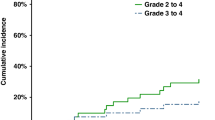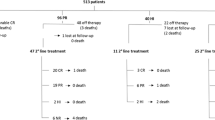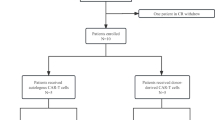Abstract
We describe the results of treatment with 2'-deoxycoformycin (DCF) in 68 patients with post-thymic (mature) T-cell malignancies. These included: prolymphocytic leukaemia (T-PLL), 31, HTLV-1 + adult T-cell leukaemia/lymphoma (ATLL), 20, cutaneous T-cell lymphoma (CTCL), comprising mycosis fungoides and Sezary syndrome, 13, and large granular lymphocytic leukaemia, four. Two-thirds of patients were refractory to previous therapy, which included four drug combinations. DCF was given intravenously at 4 mg m-2 weekly for the first 4 weeks and then every 2 weeks until maximal response. Toxicity was very low with only one death resulting from prolonged neutropenia. Overall response rates, partial (PR) and complete. (CR), were 38%, with variations according to diagnosis. Best responses, 54%, were seen in CTCL but limited to Sezary patients, one CR, six PR, whilst none of the mycosis fungoides responded. Responses in T-PLL were recorded in 48% including three CR (of 8-12 months' duration unmaintained) and 12 PR. Fifteen per cent of responses were seen in ATLL. The only ATLL responders - two CR, one PR - were those patients who received combination chemotherapy prior to DCF, with reduction of tumour bulk but short of PR. When results were analysed according to membrane phenotypes it was apparent that responses were seen mainly in cases with CD4+, CD8- T cells -22 of 47 (47%) - contrasting with only three of 19 (16%) with other T-cell phenotypes. We conclude that DCF is a useful therapy for the treatment of T-cell leukaemias, in particular Sezary syndrome and T-PLL, and should play a part in strategies to improve the natural history of this group of lymphoid malignancies.
This is a preview of subscription content, access via your institution
Access options
Subscribe to this journal
Receive 24 print issues and online access
$259.00 per year
only $10.79 per issue
Buy this article
- Purchase on Springer Link
- Instant access to full article PDF
Prices may be subject to local taxes which are calculated during checkout
Similar content being viewed by others
Author information
Authors and Affiliations
Rights and permissions
About this article
Cite this article
Dearden, C., Matutes, E. & Catovsky, D. Deoxycoformycin in the treatment of mature T-cell leukaemias. Br J Cancer 64, 903–906 (1991). https://doi.org/10.1038/bjc.1991.423
Issue Date:
DOI: https://doi.org/10.1038/bjc.1991.423
This article is cited by
-
Adult T-Cell Leukemia: a Comprehensive Overview on Current and Promising Treatment Modalities
Current Oncology Reports (2021)



